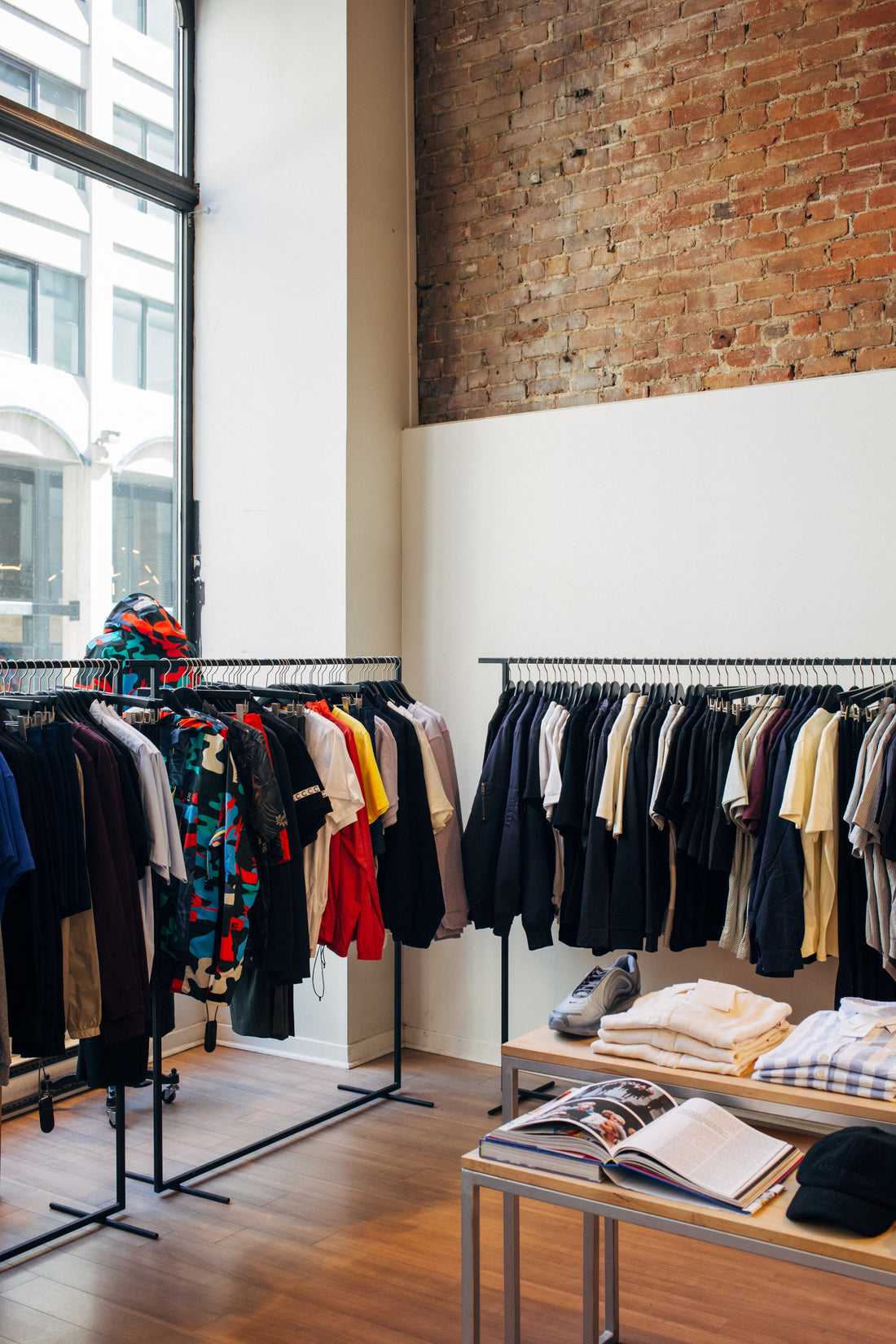
A Guide to Distribution for Fashion Startups
Share
The road from conception to the wardrobe is laden with a multitude of decisions and one of the most critical ones is choosing the right distribution channels.
In essence, the best product in the world is of no value if it can't reach its desired market.
The power of effective distribution can significantly shape a brand's visibility, sales, profitability, and overall success. As a clothing brand keen on carving a name for yourself in this competitive landscape, this guide is for you. It's tailored to explain the nuances of distribution, potential strategies, and how you can tailor them to fit your brand's unique mission
What is a Distribution Channel?
Distribution channels represent the path that your products take from the production line to the customer's hands. They serve as the bridge between your creative ideas and the retail world, where customers experience your brand. To put it plainly, your distribution channels are the avenues through which your products travel to reach your consumers.
These distribution channels could be the physical storefronts on your city's bustling high streets, the digital platforms humming with activity round the clock, or the various intermediaries such as retailers and wholesalers who act as links in the supply chain.
The distribution strategy you adopt plays a key role in determining how far your products reach and how quickly they can get there. An effective strategy can enable you to reach consumers globally or focus on a niche local market, based on your brand's mission and vision.
Without a robust distribution strategy, even the best-designed clothing line might fail to reach its intended audience.
Statistics back the importance of distribution in the fashion world too. A report by McKinsey highlighted that successful fashion companies are 2 times more likely to have a well-defined distribution strategy than their less successful counterparts. The rapid global expansion of brands like Zara and Uniqlo can be attributed, in part, to their well-crafted distribution strategies.
Understanding Your Audience and Target Market
Distribution isn't a one-size-fits-all kind of game. It must be tailored based on your target audience. This involves understanding who your customers are, their preferences, and how they like to shop.
Is your brand geared towards millennials looking for sustainable fashion options? Or are you catering to the middle-aged demographic looking for quality and comfort? Identifying your target market and designing your distribution strategy to fit their preferences is crucial for brand success.
Once your target market is defined, you need to study their buying behaviors. Are they impulse buyers who are driven by the latest trends and sales? Or are they cautious shoppers who research extensively before making a purchase? Are they tech-savvy consumers who prefer shopping online or traditional consumers who prefer the tactile experience of shopping in a store?
These insights will help you choose the most effective distribution channels. For instance, if you're catering to a younger, more digital-savvy audience, focusing on e-commerce and social media marketing may yield the best results. On the other hand, if your target market consists of consumers who prefer to try before they buy, partnering with physical stores may be a more effective strategy.
Understanding your target audience and matching them with the right distribution channel is not a one-time activity. Consumer behavior evolves with time, technology, and trends. As a fashion brand, staying in tune with these changes and adapting your distribution strategy accordingly is key to staying relevant and successful.
Different Types of Distribution Channels in the Fashion Industry
Direct-to-Consumer (DTC): Selling directly to consumers eliminates the middlemen. This can be achieved through online stores, brick-and-mortar stores, or even pop-up shops. The DTC model allows brands to maintain control over their product pricing, presentation, and brand image. For instance, brands like Warby Parker and Bonobos have reaped the benefits of the DTC model by offering high-quality products at competitive prices. By cutting out the middlemen, they've been able to pass on the savings to the consumers while still maintaining healthy profit margins.
Wholesale: This involves selling your products in bulk to retailers or boutiques who then sell to consumers. The advantage of this channel is that it can provide a wide reach, especially for luxury brands that require a high-end retail environment to match their brand identity. The downsides are lower profit margins and less control over your brand's presentation.
Distributors: Distributors handle a lot of the grunt work - they buy from you, store the goods, sell to retailers, and often also manage delivery to the stores. This can considerably lessen your operational load. But the flip side is less control and lower profits.
Agents and Representatives: These are individuals or entities who represent your brand and get your collection in front of potential buyers, often for a commission. This channel can be useful if you're looking to break into new markets or lack the bandwidth to manage sales yourself.
While these are distinct distribution channels, remember that they aren't mutually exclusive. Many successful fashion brands today adopt an omnichannel approach, where they leverage multiple distribution channels simultaneously.
Choosing the right distribution channels involves a careful analysis of your brand, your target customers, the resources at your disposal, and your long-term goals.
Strategies to Get Your Clothes Into Stores
Getting your clothes into physical stores - be it large retailers, boutiques, or even your own branded stores - involves several strategic steps.
The first step is to build a strong brand identity. This goes beyond just a catchy name and logo. Your brand identity includes your brand mission, vision, values, and the unique attributes of your products. Essentially, it's the image your brand projects to the world and how it distinguishes itself from competitors.
In addition to a strong brand identity, you must also establish your unique selling proposition (USP). What is it about your clothing line that sets it apart from others in the market? Is it the design, the quality, the price, the sustainable materials, or the ethical manufacturing processes you employ?
Retailers are more likely to stock brands that have a clear identity, align with their own brand image, and offer something unique to their customers.
Next, you need to approach the right retailers. Researching and identifying retailers whose brand image aligns with yours increases your chances of being stocked.
Presenting your collection to retailers requires careful planning. This usually involves creating a line sheet that includes photos of your collection, details about each item, and wholesale and retail prices. You may also need to develop a compelling pitch that highlights your brand's USP and potential benefits to the retailer.
Consider participating in trade shows and fashion events, where you can showcase your collection and network with potential retailers and distributors. You could also hire sales representatives who have the right contacts in the industry and can represent your brand effectively.
Finally, always be prepared for rejection. Not every retailer will be interested in your brand, and that's okay. Persistence and adaptability are key. Use feedback to improve your product and approach and keep looking for the right fit.
Remember, getting your clothes into stores is not the end. Maintaining strong relationships with retailers, staying on top of inventory management, and ensuring your brand's presence is well-received by consumers are ongoing tasks that require equal attention.
Wrapping Up
The journey of a fashion startup can be arduous, yet rewarding. And one of the most important elements of that journey is crafting an effective distribution strategy. With a clear understanding of your target market, a well-defined brand identity, and the right mix of distribution channels, you can ensure your clothing line reaches the right audience.
Building a strong distribution strategy doesn't happen overnight. It's a process that requires continuous learning, adaptation, and perseverance. But the results can transform your brand from just another name in the fashion industry to a widely recognized and sought-after label.
As you navigate your way through the fashion world, remember that every successful brand has faced its share of challenges. But with a clear vision, strategic planning, and relentless execution, your brand can not only survive but thrive and leave an indelible mark in the ever-evolving world of fashion.
This guide serves as a stepping stone to understanding and building your distribution strategy. The road ahead is challenging but exciting. So gear up, make informed decisions, and get ready to take the fashion world by storm.
